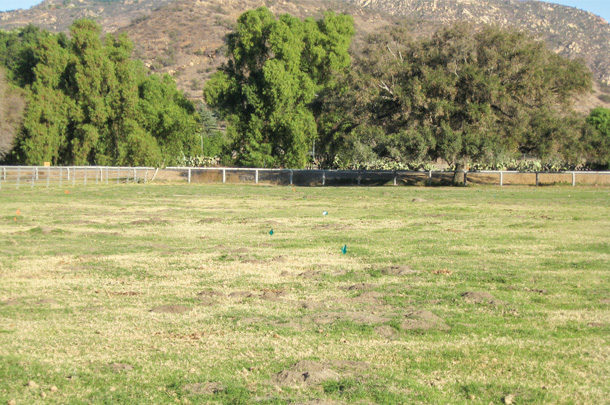Livestock pests aren’t limited to grubs, lice, flies or other types of flying insects. Rodents also damage feed sources and supplies, forage and grain harvesting equipment, and range and pasture lands.
Roger Baldwin, cooperative extension specialist at UC – Davis, says different species and genuses of gophers inhabit various areas of the U.S. Some are larger, some smaller – but functionally they’re similar, causing the same type of damage and feeding on the same kinds of feed resources.
Major infestations of gophers appear particularly in the western and midwestern U.S., although species also branch into southeastern states.
“Pocket gophers are a fossorial animal, which means they live underground, within burrow systems,” says Baldwin. “Essentially, they’re a solitary species, not living in groups like ground squirrels or prairie dogs.”
Gophers don’t hibernate and are active year-round, constantly creating new tunnels, taking the soil from fresh diggings and backfilling old systems. Even when not creating mounds aboveground, they’re still digging new burrows. When finished with one, they fill it and move on to the next. After large rainfall events, the results of aboveground mounding often become more significant, while hot and dry conditions yield fewer disturbances.
Feeding and breeding
Baldwin explains the reason for the gopher’s constant tunneling is a never-ending search for food sources.
“They’re continually digging, looking for access to new food resources, regularly feeding on the taproots of plants, mostly herbaceous materials. They’ll pull a whole plant down into the tunnel and feed on it there.”
 Pasture is pictured showing the mounds and damage created by gophers. Photo provided by R. Baldwin, UC – Davis.
Pasture is pictured showing the mounds and damage created by gophers. Photo provided by R. Baldwin, UC – Davis.
Gophers also create “feeder holes,” openings in the ground from a shallow network where they eat the vegetation around the hole in the form of a circle, then retreat underground to cover the hole. As they’re susceptible to predation, they don’t actively forage aboveground. Instead, they prefer feeding on tuberous roots and vines, below-ground portions of bark in the cambium layer from where they derive nutrients and energy resources. Their constant digging and damage to root systems limits hay and pasture production.
Fortunately for cattle producers and hay farmers, litter sizes are generally quite small, says Vanessa Corriher-Olson, professor and forage specialist at Texas A&M AgriLife Extension.
“Their lifespan is one to two years, and they normally have two litters per year,” she says. “With a gestation period of 18 to 51 days, depending on species, litter sizes range from one to six but average about two. They’re not as reproductive as wild pigs, but two babies twice a year adds up fairly quickly.”
Equipment and plant damage
Corriher-Olson says while damage to pasture and forage crops is significant in Texas and Oklahoma, damage to equipment such as herbicide and pesticide sprayers, and mowing and haying machines, is the largest result of gopher infestations.
“The tunnels they create produce mounds of dirt on the surface, interfering with crop production and weed control operations,” she says. “Often, the large number of mounds aren’t noticed in the taller forage of hay meadows until the equipment is in the fields. Repairing machinery is expensive, and this quickly impacts the production and harvesting of a crop. When it influences the timeline of an ag practice, it’s a large challenge and creates a huge impact.”
She explains a single gopher might extend their burrowing network as much as 800 feet covering an acre of ground at a depth of a few inches to several feet.
While intensive study and research is lacking on effects to plant populations caused by the pocket gopher, a 1989 study by noted University of California – Berkeley ecologist, conservation biologist and vertebrate biologist William Z. Lidicker Jr. determined a daily consumption rate per gopher averaging 119 grams (dry weight) per kilogram of bodyweight would amount to a net loss of 8% of forage (approximately 813 pounds [dry weight] per acre) when 32 gophers occupied a single acre.
Baldwin adds that soil erosion can also become a significant issue, particularly on hillside hay and pastureland. Heavy rainstorms on gopher-infested land can push water through tunnel networks, creating slumping and loss of soil. This leads to sediment washing into waterways plus varying degrees of soil erosion.
Lethal control methods
Corriher-Olson outlines the two most common options for control in her nearby states are trapping and bait dropping.
Trapping works well but is challenging, as traps need to be buried underground in a tunnel. The process requires multiple traps with locations recorded. Many become lost, as predators such as coyotes dig them up and carry both trap and deceased gopher away.
She describes using a probe to identify tunnels, then baiting with a strychnine applied bait or rodenticide dropped underground as working fine over small areas. Specifically designed baiting equipment pulled behind a vehicle can also be used to create a burrow where poison is dropped.
Fumigants could be employed, but permissible options vary from state to state, says Baldwin. Exhaust created by pressurized machines, injected into burrows, is another alternative for control. Aluminum phosphide caplets or pellets placed into tunnels react with ground moisture creating phosphine gas, which is toxic for gophers.
“Some of these are restricted-use products, which mean you must be a certified applicator to use them. These are considerations before you decide to use these pesticides,” he says.
Baldwin suggests barn owls are also generating interest with their potential to help control rodent populations in certain areas. Some farmers have erected barn owl boxes to encourage their hunting in specific regions and reported benefits with this approach. With relatively high densities of barn owls in an area, he says it’s something for a rancher to consider – but warns gains are still being studied and may be limited.
“Controlling gophers is a tough proposition,” Baldwin says. “It’s hard to quantify how many is too many in a hayfield or pasture. Ultimately, it depends on how large a ranch is versus field sizes. With small operations, control is more practical – but on a large scale, gopher management isn’t normally feasible or deemed to be cost-effective. It becomes an acceptable loss of production.”










